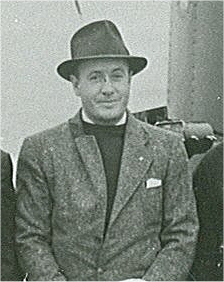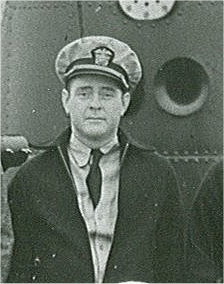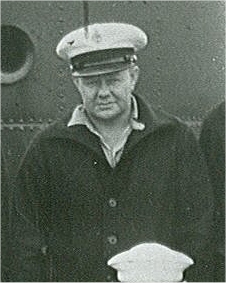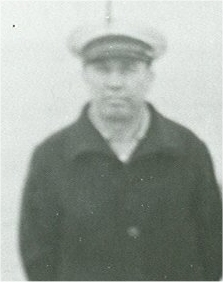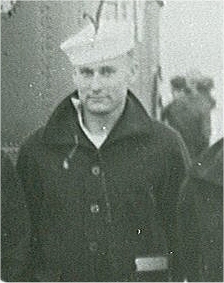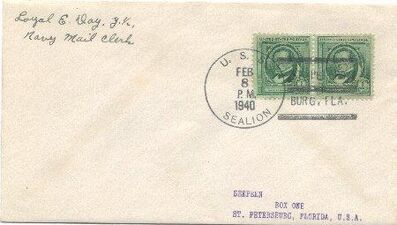195: Difference between revisions
Created page with "Category:Fleet Submarines === File:Header 4 New.jpg=== File:Red bar sub new.jpg === '''USS Sealion SS 195 ''' ===" |
Pbcjohnston (talk | contribs) SEO updates |
||
| (19 intermediate revisions by 2 users not shown) | |||
| Line 1: | Line 1: | ||
[[ | {{#seo:|title=USS Sealion (SS-195) - PigBoats.COM|title_mode=replace|keywords=USS Sealion submarine, USS Sealion submarine photos, 1st submarine loss of WWII}} | ||
{{#seo:|description=Notes, photographs, and pictures of the U.S. Navy's submarine USS Sealion (SS-195)}} | |||
[[File:Hew Header Salmon-class.jpg]] | |||
=== <big>Notes</big> === | |||
<div style="text-align: justify;"><span style="color:#00008B">Some inaccurate information has been promulgated over the years about the loss and ultimate fate of the Sealion. Most of it was due to an incomplete understanding of where the Sealion was moored, and where she actually ended up. | |||
When she was sunk, Sealion was moored outboard of Seadragon at Machina Wharf at the Cavite Navy Yard. Seadragon received only minor damage and was quickly pulled out from between the wharf and the wreck of the Sealion. Sealion remained where she sank and her wreck prevented the further use of the valuable Machina Wharf. | |||
[[File:Cavite and Sangley Point.png|right|500px]] | |||
The Japanese captured Manila and Cavite on January 3, 1942 and immediately set to work refurbishing the yard for their own use. Needing Machina Wharf, they raised the wreck from the shallow water. It was thoroughly examined but found to be of no value. It was carefully towed away north across Canacao Bay to a location just off Sangley Point and dropped in the water parallel to the shoreline, once again with portions of the wreck visible above water. It sat there until the end of the war, and when U.S. and Filipino forces retook Manila, Cavite, and Sangley Point in March 1945 the wreck was still where the Japanese had left it. Despite what captions on U.S. photographs say, Sealion WAS NOT at the Cavite yard at the end of the war. She was resting along the southern shore of Sangley Point. The chart on the right illustrates these locations. | |||
The 1959-1960 salvage work fully raised the wreck (see below). However, the exact fate of the Sealion's remains is a bit of a mystery. No documentation has yet been found that tells of how the wreck was disposed of. The most likely explanation is that she was sold for scrap to a local company. However, the webmasters have also theorized that she may have been towed out into Manila Bay and scuttled in deep water past Corregidor and Fort Drum. Whatever her final fate, Sealion is now a part of the honored past. | |||
[[File:Red bar sub new.jpg]] | |||
<div style="text-align: justify;"><span style="color:#000000"> | |||
=== <big>Launch, Trials, and Early Operations</big> === | |||
[[File:Sealion launch.jpg|left|500px]] | |||
<div style="text-align: justify;"><span style="color:#00008B">Sealion sliding down the ways at the Electric Boat Company, Groton, CT. at 4:15 pm on May 25, 1939. Note the rather advanced state of construction at this time. Most of the topside work is complete, with only internal work (like the installation of batteries) remaining. This was a typical state for submarines launched at Electric Boat in the immediate pre-war era. | |||
Sealion was the 131st vessel built for the U.S. Navy by Electric Boat. | |||
<small>Photo provided by MMCM(SS) Greg Peterman, USN (Ret.)</small> | |||
[[File:Red bar sub new.jpg]] | |||
[[File:Sealion launch day.jpg|left|500px]] | |||
Sealion on her launch day, May 25, 1939 at the Electric Boat Company in Groton CT. The Sealion is floating on her own for the first time just moments after her launch into the Thames River. The photo caption stating that it was a somber launch as recovery efforts were ongoing to salvage the [[192 salvage|'''Squalus''']]. | |||
<small>AP Wire photo in the private collection of Ric Hedman.</small> | |||
[[File:Red bar sub new.jpg]] | |||
[[File:Sealion stbd bow.jpg|left|500px]] | |||
Sealion conducting sea trials and measured mile runs surfaced and submerged off Provincetown, Massachusetts, late summer 1939. Here she is cruising past the camera boat for a series of publicity photos. What looks like a man on the deck forward of the conning tower is actually the mount for a .50 caliber machine gun. | |||
<small>U.S. Navy photo.</small> | |||
[[File:Red bar sub new.jpg]] | |||
[[File:Sealion trials.jpg|left|500px]] | |||
Another view of Sealion on trials in Cape Cod Bay, MA. late summer of 1939. In this photo there are two men on deck alongside the conning tower fairwater. Both appear to be officers based on their uniforms. They may be topside verifying the rig for dive. | |||
<small>U.S. Navy photo.</small> | |||
[[File:Red bar sub new.jpg]] | |||
[[File:Sealion crew 1.jpg|left|500px]] | |||
At least eight of the Sealion crew shown in this photo are named, circa 1939. At this time it is only a high probability that all the men in this photo are Sealion crewmen. The men identified are all members of the Commissioning crew roster. The fact that the rest of the crewmen are not identified may indicate that this is a combined crew photo, perhaps of an athletic team for two boats. The boat that they are standing on is definitely either Sealion or Seadragon. The known crewmen are identified in the gallery below. | |||
LT J.K. Morrison, the commanding officer, would unfortunately pass away under tragic circumstances in February 1940. See his story via the link under his picture below. | |||
The light colored oval plates on the fairwater behind the men are sonar transducers for the QCG or QCH passive sonar system. Mounting them here allowed the system to be used even if the sub were sitting on the bottom. | |||
<small>Image courtesy of Mike Kaup.</small> | |||
[[File:Red bar sub new.jpg]] | |||
<center> | |||
<gallery mode="packed" widths="200px" heights="300px"> | |||
File:Sealion morrison.jpg|[[Morrison|'''LT Julian Knox Morrison, Jr., CO''']] | |||
File:Sealion moore.jpg|LT John R. Moore, XO | |||
File:Sealion raborn.jpg|LTjg Albert Raborn | |||
File:Sealion thompson.jpg|LTjg W.C. Thompson | |||
File:Sealion gerdes.jpg|CTM Richard W. Gerdes | |||
File:Sealion hurst.jpg|CEM Joseph Hurst | |||
File:Sealion rogers.jpg|CMM William J. Rogers | |||
File:Sealion hantsche.jpg|TM 1c Edgar M. Hantsche | |||
</gallery> | |||
</center> | |||
<div style="text-align: justify;"><span style="color:#00008B">Closeups of the crew photo above. We have interesting information about Morrison, see the link under his name. Why Morrison and Moore are in civilian clothes is not known. | |||
[[File:Red bar sub new.jpg]] | |||
[[File:Sealion commissioning program 1.jpg|left|500px]] | |||
[[File:Sealion commissioning program 2.jpg|left|500px]] | |||
Crew list from the program for the commissioning ceremonies for Sealion, November 27, 1939. Ric Hedman's cousin, YN 1c Loyal E. Day, is the ninth name down on the crew list. | |||
LT(jg) Eli T. Reich (listed here as the Engineer Officer) eventually went on to command the [http://www.navsource.org/archives/08/08315.htm '''USS Sealion (SS-315)'''], the second submarine to carry the name. Reich and the new Sealion scored an impressive victory in November 1944 by sinking the Japanese battleship Kongo. | |||
<small>Image courtesy of Marty Danford.</small> | |||
[[File:Red bar sub new.jpg]] | |||
<center> | |||
<gallery mode="packed" widths="250px" heights="150px"> | |||
File:Sealion cover 1.jpg | |||
File:Sealion cover 2.jpg | |||
File:Sealion cover 3.jpg | |||
</gallery> | |||
</center> | |||
<div style="text-align: justify;"><span style="color:#00008B">Three postal covers from Sealion's early days, collected by Ric Hedman as they have his cousin's name, Loyal E. Day, written in his own hand. | |||
<small>All in the private collection of Ric Hedman.</small> | |||
[[File:Red bar sub new.jpg]] | |||
[[File:Sealion baseball team.jpg|left|500px]] | |||
Sealion's baseball team, date unknown, probably circa 1940. Photo most likely taken on the Sealion's deck. In the second row back on the far-right side the two men there have been identified as Pharmacist's Mate 2c Wheeler Lipes (R) and Fireman 2c Henry B. Jones (L). In the background is a small boat with the number 197. If the boat belonged to the outboard submarine, that would make it the [[197|'''USS Seawolf (SS-197)''']]. The center boat is not identifiable. | |||
Lipes would go on to become a Submarine Force legend. In these days submarines did not carry doctors. A single Pharmacist's Mate (PHM) was the only medical staff onboard. PHM's were trained in first aid, hospital administration, patient care, and were authorized to dispense medicines as indicated. That was it. They had no other medical training. Lipes survived the Sealion's bombing in Cavite at the start of the war and was transferred to [[194|'''Seadragon''']]. While on Seadragon's fourth war patrol on September 11, 1942 one of Lipes' shipmates came down with acute appendicitis. Knowing that the sailor would die without an operation, Lipes performed a successful appendectomy with the boat submerged using makeshift surgical instruments while reading out of a surgical manual. SN 1c Darrel D. Rector not only survived, but was returned to full duty after recovery. The first surgery aboard a submarine set a precedent of much more intensive training for submarine PHM's, and Lipes' courage, fortitude, and steady hand were an inspiration to the whole force. Rector's trust in his shipmate is illustrative of the bond between submariners. | |||
Many thanks go to Bryan Jones for this great copy of the Sealion baseball team. Thanks also to Larry Johnson for another copy this photo. His uncle Clarence H. Johnson served aboard the Sealion as a Seaman 2nd Class. LT Clarence H. Johnson later died while serving aboard the USS Golet (SS-361) when she was sunk by the Japanese on June 14, 1944. Identifications of Henry Jones by Bryan Jones, son of Henry Jones. | |||
[[File:Red bar sub new.jpg]] | |||
<div style="text-align: justify;"><span style="color:#000000"> | |||
=== <big>War and Loss</big> === | |||
[[File:Sealion Cavite.jpg|left|500px]] | |||
<div style="text-align: justify;"><span style="color:#00008B">This photo shows Naval Station Cavite in Manila Bay, Philippines shortly after the Japanese attacked on December 10, 1941. The shipyard was left in shambles and aflame. To the lower right-hand edge of the photo you can see the bow of the Sealion. She had been hit by two bombs. One hit the after end of the cigarette deck and exploded, sending shrapnel flying everywhere. A piece penetrated the conning tower of the [[194|'''Seadragon''']] moored next to Sealion, hitting and killing Ensign Samuel H. Hunter, Jr. The second bomb hit at the juncture of the engine room/maneuvering room, instantly killing four men working on rebuilding electric motors. Their bodies were not recovered until the Sealion's hulk was fully salvaged in 1959. Rest in peace shipmates.<br><br> | |||
•CEM Sterling Cecil Foster<br> | |||
•CEM Melvin Donald O'Connell<br> | |||
•MM 1c Ernest Ephrom Ogilvie<br> | |||
•EM 3c Vallentyne Lester Paul<br> | |||
In addition to these deaths, two more Sealion crewmembers died as a POW, having been captured after the fall of the Philippines.<br><br> | |||
•MM 1c Howard Firth<br> | |||
•SN 1c Harold Gerald Gearhart | |||
<small>U.S. Navy photo.</small> | |||
[[File:Red bar sub new.jpg]] | |||
[[File:Sealion Cavite 2.jpg|left|500px]] | |||
Sealion was badly damaged, and in the chaos that followed the initial Japanese attacks on the Philippines, it was found that nothing could be done to repair her. Towing her to Hawaii (the next nearest Navy Yard) was impossible so she was systematically stripped of any useful equipment, which was transferred to other submarines in need. Any remaining equipment was thoroughly wrecked. When this work was completed, her crew was transferred to other boats or commands. Unfortunately a few did not make it out and became members of Luzon's defense force. Two (Firth and Gearhart) were captured and died as a POW. | |||
On Christmas Day 1941, three depth charges were detonated inside her wreck, ensuring nothing useful remained, although the wreck remained mostly intact. Sealion is seen in the center of this photo of Machina Wharf at Cavite shortly after this wrecking was completed. It sat where she was sunk at her mooring. This is how the Japanese found her on January 3, 1942 when they took control of Cavite. The Japanese quickly moved to make Cavite a functioning base for their Navy, but Sealion was in the way. They raised her, studied what remained, then moved the wreck to an out of the way spot just to the north at Sangley Point, where they dropped it in shallow water. | |||
<small>Photo 80-G-243717 courtesy of the NHHC.</small> | |||
[[File:Red bar sub new.jpg]] | |||
[[File:Sealion wreck.jpg|left|500px]] | |||
The condition of Sealion's wreck during the Japanese salvage efforts, January 1942. Her wreck was of no use to them just as the USN wanted it to be. They did take this photo of the damage to the conning tower fairwater. After the war it was found in among the captured documents. The quality of this many times copied image is bad and Ric worked very hard to improve the photo so the details of the damage can be seen. | |||
A large piece of fairwater plating can be seen peeled away and folded back to the left at the bottom of the two smokestacks in the background. Another large section of steel is seen folded upwards on the port side of the periscope sheers. More difficult to see is another large section folded down by the force of the explosion right towards the camera and appears as a white colored object in the center bottom of the photo. In the left center of the photo there is a triangular remnant of the aft end of the fairwater still standing. Everything else was simply blown away by the explosion. Destroyed was the Sealion's main induction and ventilation intake valves that were right where the bomb hit. The oval door leading from the conning tower to allow access to the main deck can be seen in the lower center of the photo. | |||
<small>Photo 1010058 courtesy of the NHHC.</small> | |||
[[File:Red bar sub new.jpg]] | |||
[[File:Sealion wreck 2.jpg|left|500px]] | |||
After the Japanese were done with the wreck, they towed it around Cavite Point and to the north about a mile to Sangley Point, where they dropped it in shallow water, portions of it still visible. This photo shows how she was found in November 1945 when U.S. forces reoccupied the Cavite/Sangley area. All the plating around the conning tower has been stripped away, probably by the Japanese for projects and repairs of their own. A Filipino man can be seen fishing off the top of the conning tower. This view is from the forward port side of the conning tower looking aft. | |||
<small>Photo NH 85725 courtesy of the NHHC.</small> | |||
[[File:Red bar sub new.jpg]] | |||
[[File:Sealion butler.jpg|left|500px]] | |||
MM 1c Everett Butler, former Sealion crewmember. Photo taken in 1944. The below was sent to Ric Hedman by Butler about 15 years ago: | |||
''I was on the Sealion from Oct 41 to Dec 41. Was a F2C in the FWD Engine Room. Before the yard period at Cavite I, along with another fireman and Chief Rogers, were working on modifying the pistons for the main engines for the upcoming yard overhaul.'' | |||
''The yard overhaul was to be completed by Dec 13 but the air raid on Dec 10 ended all of that.'' | |||
''It was a Wednesday and work schedule had been increased a few hours each day. We had just had lunch in the mess hall in the dock area in the navy yard and returned to the ship waiting to return to work at 1 when the air raid sirens went off. We received two direct bomb hits, one on the cigarette deck at the after end of bridge area. The other, either in the after engine room or maneuvering room. This one really done us in as we lost the main motor reduction gears and of course the entire switching equipment for electric power. The switches were all apart having been rebuilt by the EMs.'' | |||
''We lost 3 EMs and one MM1. Since we were outboard of Seadragon alongside the wharf we settled in the water with only the stern and the deck from just aft of the conning tower under water.'' | |||
''Most of the Sealion crew went on to the dock and manned fire hoses to fight fires in the wooden buildings. The fire got to the torpedo warheads and they began to explode, then many of us jumped into the water beside the dock.'' | |||
''When the fires were out and the yard was in waste, Captain Voge sent Utz to find us a boat so we could get across Manila Bay to the Canopus alongside one of the city piers. Utz came back with the Admiral's Barge, we all got on board and headed for the Canopus.'' | |||
''The next several days were spent getting classified material off the boat On the 17 of Dec the Sailfish came in, their skipper had asked to be relieved, and Voge took command. Four Sealion sailors went on board, Riley RM1; Johnson SM1; Elsasser SN; and Butler FN. Later, I think in Java, we also picked up Rahl, Utz and McCurdy FN, making a total of 8 Sealion sailors on board Sailfish. PHM (Wheeler) Lipes went to Seadragon, he died just last year, was a LCDR retired. He did the appendectomy operation.'' (On Seadragon) | |||
''Hope this helps you out.'' | |||
''I am treasurer of Wisconsin Base SubVets Inc.'' | |||
''Everett Butler'' | |||
<small>Story and photo courtesy of Everett Butler.</small> | |||
[[File:Red bar sub new.jpg]] | |||
[[File:Sealion jones.jpg|left|500px]] | |||
MM 2c Henry Brogden Jones while still aboard the Sealion. After the Sealion was sunk he was transferred to the [[186|'''USS Stingray (SS-186)''']]. He later made Chief and then Warrant Officer. | |||
<small>Photo courtesy of Bryan K. Jones, son of Henry Brogden Jones.</small> | |||
[[File:Red bar sub new.jpg]] | |||
[[File:Sealion Iden.jpg|left|500px]] | |||
John Harold Iden, Jr. seen here on an unidentified date and location. He is qualified in submarines at this point. His Qualified in Submarines dolphin patch can be seen sewn on his right sleeve. | |||
According to his family John Iden's service once he left the bombed Sealion was; ''"...on the USS Permit on 09-Feb-1942 in Surabaya, Java (Dutch Netherlands submarine base). There are no records for the period 10-Dec-1941 through 09-Feb-1942 (60-days). His medical record cites that he was on Bataan and Corregidor and survived on berries. But how did he get to be on the Permit? He also later served aboard the USS Pickerel, USS Saury and the shakedown cruise of the USS Spot. He was honorably discharged 08-Dec-1944...He passed on 22-Mar-1971."'' | |||
<small>Photo courtesy of Scott Iden, son of Sealion crewman John Harold Iden, Jr.</small> | |||
[[File:Red bar sub new.jpg]] | |||
<div style="text-align: justify;"><span style="color:#000000"> | |||
=== <big>Legacy</big> === | |||
[[File:Sealion wreck 1959.jpg|left|500px]] | |||
<div style="text-align: justify;"><span style="color:#00008B">By late 1959 the USN was interested in expanding the docking facilities on the southern edge of Sangley Point. The Sealion was in the way so the decision was made to raise the wreck. This photo shows the salvage effort after the wreck was partially raised and stabilized. The wreck has been turned perpendicular to the Sangley Point shoreline. | |||
<small>Photo courtesy of Richard Crank via Navsource.</small> | |||
[[File:Red bar sub new.jpg]] | |||
[[File:Sealion crew buried.jpg|left|400px]] | |||
As the salvage work was going on it was discovered that the bodies of the four crewmen that had been killed in the initial attack where still entombed inside the after engine room. They were carefully removed under military protocol and two of them (O’Connell and Ogilvie) were returned to the States for burial by their families. The other two (Foster and Paul) were buried with full military honors at sea from the USS Princeton (LPH-5). This article from a Navy magazine details the funeral on the Princeton. | |||
The final fate of the Sealion remains somewhat in doubt. It is likely that the wreck was sold for scrapping, but this can not be currently confirmed. It has also been speculated that she was towed out to deep water in Manila Bay past Corregidor and Fort Drum and scuttled. | |||
<small>Clipping courtesy of U.S. Navy.</small> | |||
[[File:Red bar sub new.jpg]] | |||
[[File:Sealion day and hedman.jpg|left|500px]] | |||
Former Sealion crewman Loyal E. Day with his cousin and very young TN(SS) Ric Hedman in May 1969 in San Diego. This was the one and only time that Ric had the pleasure to meet his cousin and shipmate. He passed away a while after this photo was taken. See any family resemblance? | |||
<small>Photo in the private collection of Ric Hedman.</small> | |||
[[File:Red bar sub new.jpg]] | [[File:Red bar sub new.jpg]] | ||
<center>[[Salmon/Sargo Class|Return to the Salmon/Sargo class page]] | [[Submarine Classes|Return to the Submarine Classes page]]</center> | |||
= | [[File:Red bar sub new.jpg]] | ||
<center> | |||
<span style="color:#00008B"> | |||
Page created by:<br> | |||
<small>Ric Hedman & David Johnston<br> | |||
1999 - 2023 - PigBoats.COM<sup>©</sup><br> | |||
Mountlake Terrace, WA, Norfolk, VA<br> | |||
webmaster at pigboats dot com</small> | |||
</center> | |||
[[File:Subs bottom line 2.jpg]] | |||
Latest revision as of 17:38, 8 May 2025
Notes
When she was sunk, Sealion was moored outboard of Seadragon at Machina Wharf at the Cavite Navy Yard. Seadragon received only minor damage and was quickly pulled out from between the wharf and the wreck of the Sealion. Sealion remained where she sank and her wreck prevented the further use of the valuable Machina Wharf.

The Japanese captured Manila and Cavite on January 3, 1942 and immediately set to work refurbishing the yard for their own use. Needing Machina Wharf, they raised the wreck from the shallow water. It was thoroughly examined but found to be of no value. It was carefully towed away north across Canacao Bay to a location just off Sangley Point and dropped in the water parallel to the shoreline, once again with portions of the wreck visible above water. It sat there until the end of the war, and when U.S. and Filipino forces retook Manila, Cavite, and Sangley Point in March 1945 the wreck was still where the Japanese had left it. Despite what captions on U.S. photographs say, Sealion WAS NOT at the Cavite yard at the end of the war. She was resting along the southern shore of Sangley Point. The chart on the right illustrates these locations.
The 1959-1960 salvage work fully raised the wreck (see below). However, the exact fate of the Sealion's remains is a bit of a mystery. No documentation has yet been found that tells of how the wreck was disposed of. The most likely explanation is that she was sold for scrap to a local company. However, the webmasters have also theorized that she may have been towed out into Manila Bay and scuttled in deep water past Corregidor and Fort Drum. Whatever her final fate, Sealion is now a part of the honored past.
Launch, Trials, and Early Operations

Sealion was the 131st vessel built for the U.S. Navy by Electric Boat.
Photo provided by MMCM(SS) Greg Peterman, USN (Ret.)
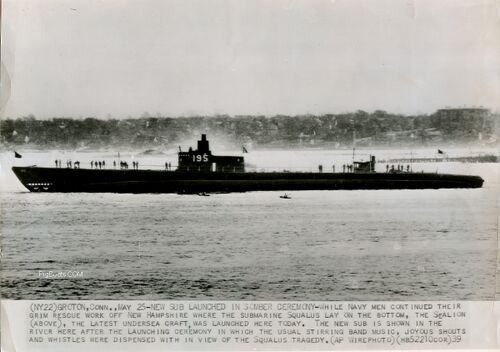
Sealion on her launch day, May 25, 1939 at the Electric Boat Company in Groton CT. The Sealion is floating on her own for the first time just moments after her launch into the Thames River. The photo caption stating that it was a somber launch as recovery efforts were ongoing to salvage the Squalus.
AP Wire photo in the private collection of Ric Hedman.
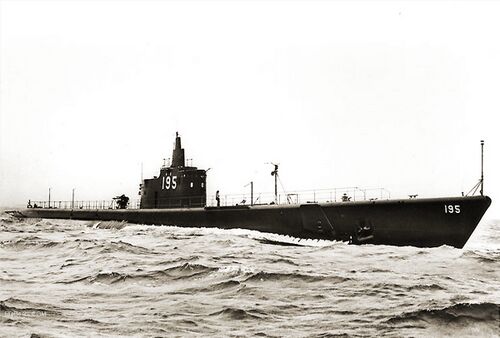
Sealion conducting sea trials and measured mile runs surfaced and submerged off Provincetown, Massachusetts, late summer 1939. Here she is cruising past the camera boat for a series of publicity photos. What looks like a man on the deck forward of the conning tower is actually the mount for a .50 caliber machine gun.
U.S. Navy photo.

Another view of Sealion on trials in Cape Cod Bay, MA. late summer of 1939. In this photo there are two men on deck alongside the conning tower fairwater. Both appear to be officers based on their uniforms. They may be topside verifying the rig for dive.
U.S. Navy photo.

At least eight of the Sealion crew shown in this photo are named, circa 1939. At this time it is only a high probability that all the men in this photo are Sealion crewmen. The men identified are all members of the Commissioning crew roster. The fact that the rest of the crewmen are not identified may indicate that this is a combined crew photo, perhaps of an athletic team for two boats. The boat that they are standing on is definitely either Sealion or Seadragon. The known crewmen are identified in the gallery below.
LT J.K. Morrison, the commanding officer, would unfortunately pass away under tragic circumstances in February 1940. See his story via the link under his picture below.
The light colored oval plates on the fairwater behind the men are sonar transducers for the QCG or QCH passive sonar system. Mounting them here allowed the system to be used even if the sub were sitting on the bottom.
Image courtesy of Mike Kaup.
-
LT John R. Moore, XO
-
LTjg Albert Raborn
-
LTjg W.C. Thompson
-
CTM Richard W. Gerdes
-
CEM Joseph Hurst
-
CMM William J. Rogers
-
TM 1c Edgar M. Hantsche
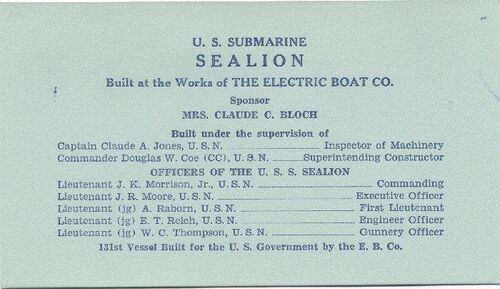
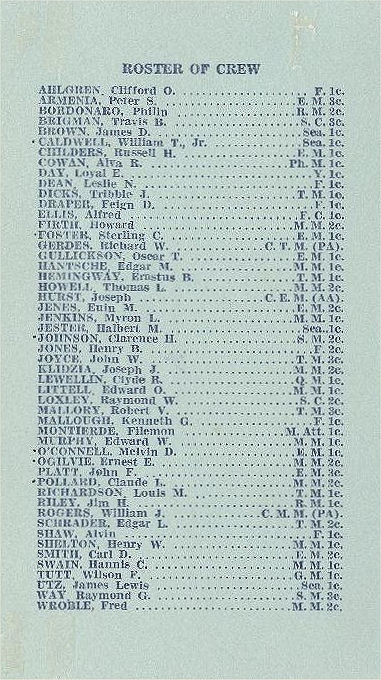
Crew list from the program for the commissioning ceremonies for Sealion, November 27, 1939. Ric Hedman's cousin, YN 1c Loyal E. Day, is the ninth name down on the crew list.
LT(jg) Eli T. Reich (listed here as the Engineer Officer) eventually went on to command the USS Sealion (SS-315), the second submarine to carry the name. Reich and the new Sealion scored an impressive victory in November 1944 by sinking the Japanese battleship Kongo.
Image courtesy of Marty Danford.
All in the private collection of Ric Hedman.

Sealion's baseball team, date unknown, probably circa 1940. Photo most likely taken on the Sealion's deck. In the second row back on the far-right side the two men there have been identified as Pharmacist's Mate 2c Wheeler Lipes (R) and Fireman 2c Henry B. Jones (L). In the background is a small boat with the number 197. If the boat belonged to the outboard submarine, that would make it the USS Seawolf (SS-197). The center boat is not identifiable.
Lipes would go on to become a Submarine Force legend. In these days submarines did not carry doctors. A single Pharmacist's Mate (PHM) was the only medical staff onboard. PHM's were trained in first aid, hospital administration, patient care, and were authorized to dispense medicines as indicated. That was it. They had no other medical training. Lipes survived the Sealion's bombing in Cavite at the start of the war and was transferred to Seadragon. While on Seadragon's fourth war patrol on September 11, 1942 one of Lipes' shipmates came down with acute appendicitis. Knowing that the sailor would die without an operation, Lipes performed a successful appendectomy with the boat submerged using makeshift surgical instruments while reading out of a surgical manual. SN 1c Darrel D. Rector not only survived, but was returned to full duty after recovery. The first surgery aboard a submarine set a precedent of much more intensive training for submarine PHM's, and Lipes' courage, fortitude, and steady hand were an inspiration to the whole force. Rector's trust in his shipmate is illustrative of the bond between submariners.
Many thanks go to Bryan Jones for this great copy of the Sealion baseball team. Thanks also to Larry Johnson for another copy this photo. His uncle Clarence H. Johnson served aboard the Sealion as a Seaman 2nd Class. LT Clarence H. Johnson later died while serving aboard the USS Golet (SS-361) when she was sunk by the Japanese on June 14, 1944. Identifications of Henry Jones by Bryan Jones, son of Henry Jones.
War and Loss

•CEM Sterling Cecil Foster
•CEM Melvin Donald O'Connell
•MM 1c Ernest Ephrom Ogilvie
•EM 3c Vallentyne Lester Paul
In addition to these deaths, two more Sealion crewmembers died as a POW, having been captured after the fall of the Philippines.
•MM 1c Howard Firth
•SN 1c Harold Gerald Gearhart
U.S. Navy photo.
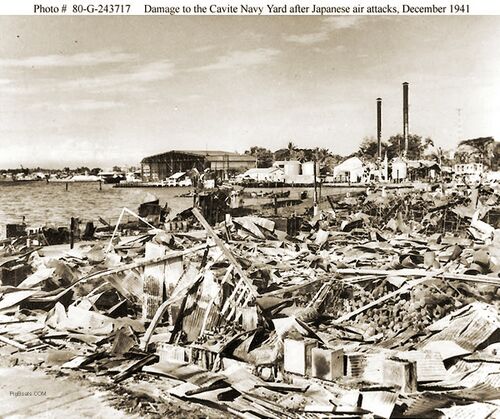
Sealion was badly damaged, and in the chaos that followed the initial Japanese attacks on the Philippines, it was found that nothing could be done to repair her. Towing her to Hawaii (the next nearest Navy Yard) was impossible so she was systematically stripped of any useful equipment, which was transferred to other submarines in need. Any remaining equipment was thoroughly wrecked. When this work was completed, her crew was transferred to other boats or commands. Unfortunately a few did not make it out and became members of Luzon's defense force. Two (Firth and Gearhart) were captured and died as a POW.
On Christmas Day 1941, three depth charges were detonated inside her wreck, ensuring nothing useful remained, although the wreck remained mostly intact. Sealion is seen in the center of this photo of Machina Wharf at Cavite shortly after this wrecking was completed. It sat where she was sunk at her mooring. This is how the Japanese found her on January 3, 1942 when they took control of Cavite. The Japanese quickly moved to make Cavite a functioning base for their Navy, but Sealion was in the way. They raised her, studied what remained, then moved the wreck to an out of the way spot just to the north at Sangley Point, where they dropped it in shallow water.
Photo 80-G-243717 courtesy of the NHHC.
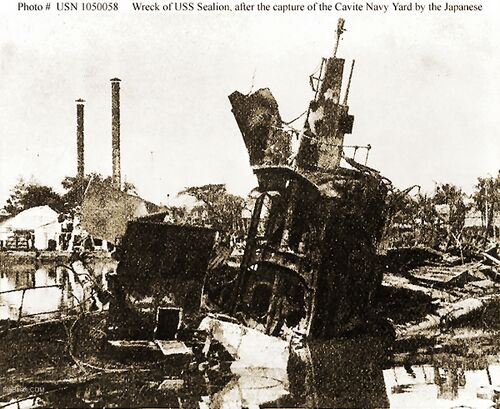
The condition of Sealion's wreck during the Japanese salvage efforts, January 1942. Her wreck was of no use to them just as the USN wanted it to be. They did take this photo of the damage to the conning tower fairwater. After the war it was found in among the captured documents. The quality of this many times copied image is bad and Ric worked very hard to improve the photo so the details of the damage can be seen.
A large piece of fairwater plating can be seen peeled away and folded back to the left at the bottom of the two smokestacks in the background. Another large section of steel is seen folded upwards on the port side of the periscope sheers. More difficult to see is another large section folded down by the force of the explosion right towards the camera and appears as a white colored object in the center bottom of the photo. In the left center of the photo there is a triangular remnant of the aft end of the fairwater still standing. Everything else was simply blown away by the explosion. Destroyed was the Sealion's main induction and ventilation intake valves that were right where the bomb hit. The oval door leading from the conning tower to allow access to the main deck can be seen in the lower center of the photo.
Photo 1010058 courtesy of the NHHC.
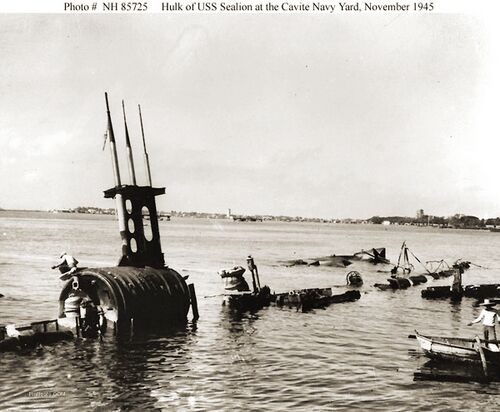
After the Japanese were done with the wreck, they towed it around Cavite Point and to the north about a mile to Sangley Point, where they dropped it in shallow water, portions of it still visible. This photo shows how she was found in November 1945 when U.S. forces reoccupied the Cavite/Sangley area. All the plating around the conning tower has been stripped away, probably by the Japanese for projects and repairs of their own. A Filipino man can be seen fishing off the top of the conning tower. This view is from the forward port side of the conning tower looking aft.
Photo NH 85725 courtesy of the NHHC.
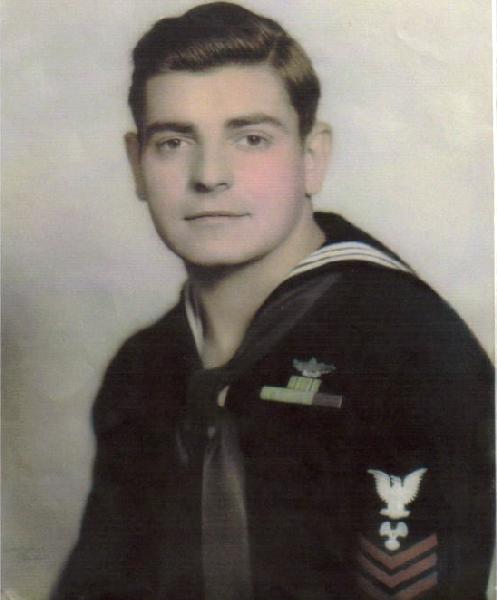
MM 1c Everett Butler, former Sealion crewmember. Photo taken in 1944. The below was sent to Ric Hedman by Butler about 15 years ago:
I was on the Sealion from Oct 41 to Dec 41. Was a F2C in the FWD Engine Room. Before the yard period at Cavite I, along with another fireman and Chief Rogers, were working on modifying the pistons for the main engines for the upcoming yard overhaul.
The yard overhaul was to be completed by Dec 13 but the air raid on Dec 10 ended all of that.
It was a Wednesday and work schedule had been increased a few hours each day. We had just had lunch in the mess hall in the dock area in the navy yard and returned to the ship waiting to return to work at 1 when the air raid sirens went off. We received two direct bomb hits, one on the cigarette deck at the after end of bridge area. The other, either in the after engine room or maneuvering room. This one really done us in as we lost the main motor reduction gears and of course the entire switching equipment for electric power. The switches were all apart having been rebuilt by the EMs.
We lost 3 EMs and one MM1. Since we were outboard of Seadragon alongside the wharf we settled in the water with only the stern and the deck from just aft of the conning tower under water.
Most of the Sealion crew went on to the dock and manned fire hoses to fight fires in the wooden buildings. The fire got to the torpedo warheads and they began to explode, then many of us jumped into the water beside the dock.
When the fires were out and the yard was in waste, Captain Voge sent Utz to find us a boat so we could get across Manila Bay to the Canopus alongside one of the city piers. Utz came back with the Admiral's Barge, we all got on board and headed for the Canopus.
The next several days were spent getting classified material off the boat On the 17 of Dec the Sailfish came in, their skipper had asked to be relieved, and Voge took command. Four Sealion sailors went on board, Riley RM1; Johnson SM1; Elsasser SN; and Butler FN. Later, I think in Java, we also picked up Rahl, Utz and McCurdy FN, making a total of 8 Sealion sailors on board Sailfish. PHM (Wheeler) Lipes went to Seadragon, he died just last year, was a LCDR retired. He did the appendectomy operation. (On Seadragon)
Hope this helps you out.
I am treasurer of Wisconsin Base SubVets Inc.
Everett Butler
Story and photo courtesy of Everett Butler.
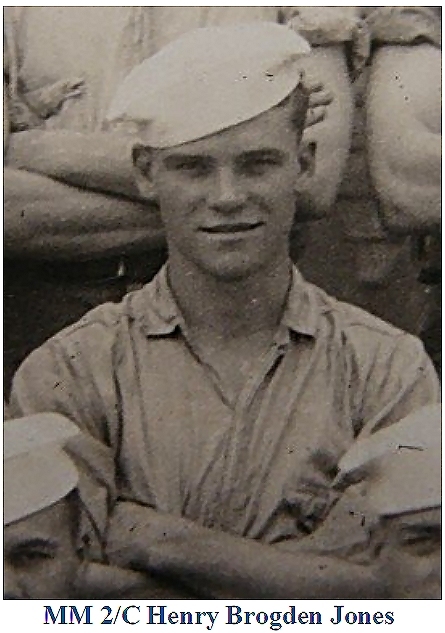
MM 2c Henry Brogden Jones while still aboard the Sealion. After the Sealion was sunk he was transferred to the USS Stingray (SS-186). He later made Chief and then Warrant Officer.
Photo courtesy of Bryan K. Jones, son of Henry Brogden Jones.

John Harold Iden, Jr. seen here on an unidentified date and location. He is qualified in submarines at this point. His Qualified in Submarines dolphin patch can be seen sewn on his right sleeve.
According to his family John Iden's service once he left the bombed Sealion was; "...on the USS Permit on 09-Feb-1942 in Surabaya, Java (Dutch Netherlands submarine base). There are no records for the period 10-Dec-1941 through 09-Feb-1942 (60-days). His medical record cites that he was on Bataan and Corregidor and survived on berries. But how did he get to be on the Permit? He also later served aboard the USS Pickerel, USS Saury and the shakedown cruise of the USS Spot. He was honorably discharged 08-Dec-1944...He passed on 22-Mar-1971."
Photo courtesy of Scott Iden, son of Sealion crewman John Harold Iden, Jr.
Legacy
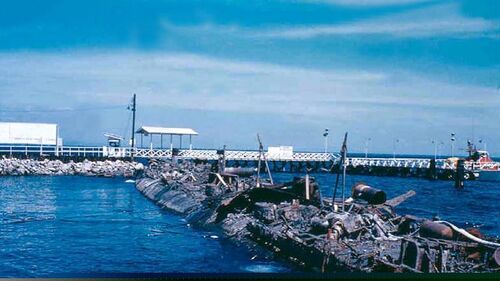
Photo courtesy of Richard Crank via Navsource.
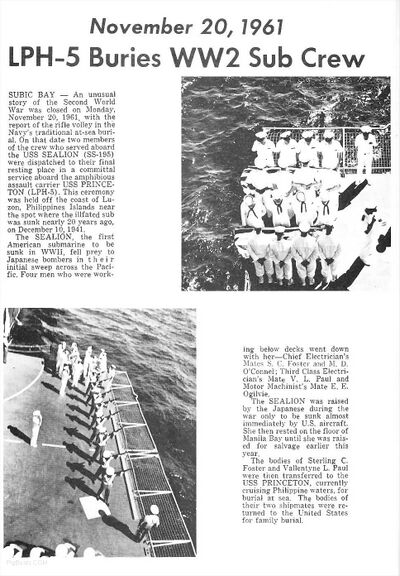
As the salvage work was going on it was discovered that the bodies of the four crewmen that had been killed in the initial attack where still entombed inside the after engine room. They were carefully removed under military protocol and two of them (O’Connell and Ogilvie) were returned to the States for burial by their families. The other two (Foster and Paul) were buried with full military honors at sea from the USS Princeton (LPH-5). This article from a Navy magazine details the funeral on the Princeton.
The final fate of the Sealion remains somewhat in doubt. It is likely that the wreck was sold for scrapping, but this can not be currently confirmed. It has also been speculated that she was towed out to deep water in Manila Bay past Corregidor and Fort Drum and scuttled.
Clipping courtesy of U.S. Navy.
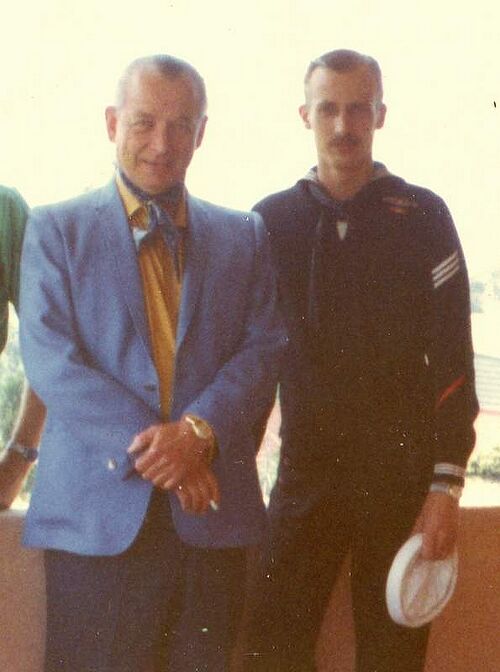
Former Sealion crewman Loyal E. Day with his cousin and very young TN(SS) Ric Hedman in May 1969 in San Diego. This was the one and only time that Ric had the pleasure to meet his cousin and shipmate. He passed away a while after this photo was taken. See any family resemblance?
Photo in the private collection of Ric Hedman.
Page created by:
Ric Hedman & David Johnston
1999 - 2023 - PigBoats.COM©
Mountlake Terrace, WA, Norfolk, VA
webmaster at pigboats dot com

